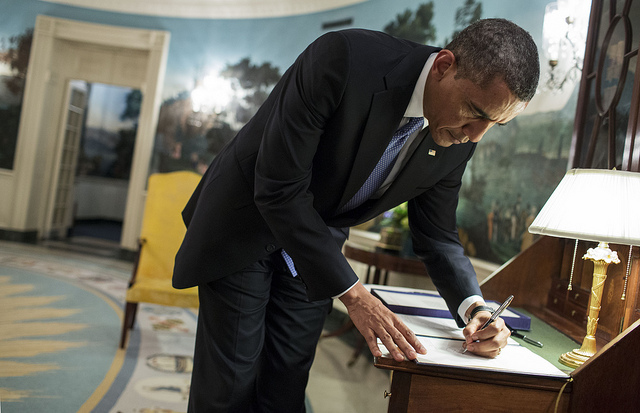The President’s Budget — 212 pages long — included a wide range of proposals and Heritage experts shed light on a number of these in a Live Analysis yesterday. Here are five things you should know about the President’s budget:
- Higher Spending and No Balanced Budget—Ever. President Obama’s budget would increase spending by $250 billion above current spending projections in 2015 alone. Part of this increase would stem from a $55 billion increase in the 2015 discretionary budget above the bipartisan spending caps put in place in 2011. The remainder comes from higher mandatory spending, including on top-down transportation projects and education programs. Despite massive tax increases, higher user fees in a number of areas, and several spending cuts to healthcare programs, the President’s budget never balances.
- $1.2 Trillion in Higher Taxes. Obama’s tax increases would push the tax burden to nearly 20 percent of GDP, near the all-time high last reached in 2000. The biggest single tax hike is a cap on itemized deductions for high-earning families which would include municipal bond income, retirement savings, and health insurance. The President also targets low-income Americans with an additional tax on cigarettes of 94 cents a pack which would come on top of the existing $1.01 in tobacco taxes.
- Fails the Nation’s Defense. The defense budget suffers from many similar ailments as the domestic budget does. Personnel costs, in particular for healthcare and retirement entitlements, eat up about half of the defense budget and their share is growing. Just as spending on federal health care and retirement benefits is increasingly crowding out discretionary funding on defense and non-defense, entitlements in the defense budget are increasingly crowding out funding for modernization and weapons systems. Obama’s failure to make important structural reforms to the defense budget, including to inefficient acquisitions systems, is making the U.S. and its global allies less secure in the long run.
- Full of Budget Gimmicks. The President plays games with the economic projections in his budget. By assuming much higher levels of economic growth and lower levels of unemployment than the non-partisan Congressional Budget Office, the President’s budget pretends to pay for some of the new spending initiatives with inflated economic assumptions. The President also claims phony savings from reducing war spending that will either be spent regardless or was not going to be spent in the first place.
- Rolls Over for Special Interests. Good governance entails making difficult decisions to do what’s best for the country, even if doing so makes for bad politics at times. Instead of tackling the country’s important budget problems with entitlement reforms and substantive spending cuts, this budget rolls over for special interests and says “don’t worry about the future fiscal crisis we can see right around the corner, let’s keep this spending party going just a little bit longer.” Case in point is Obama’s stepping back from the chained CPI, a modest, bipartisan proposal to slow the growth in federal benefit programs like Social Security, while doubling down on a stimulus program that funds such local matters as a Kansas trolley car.






























